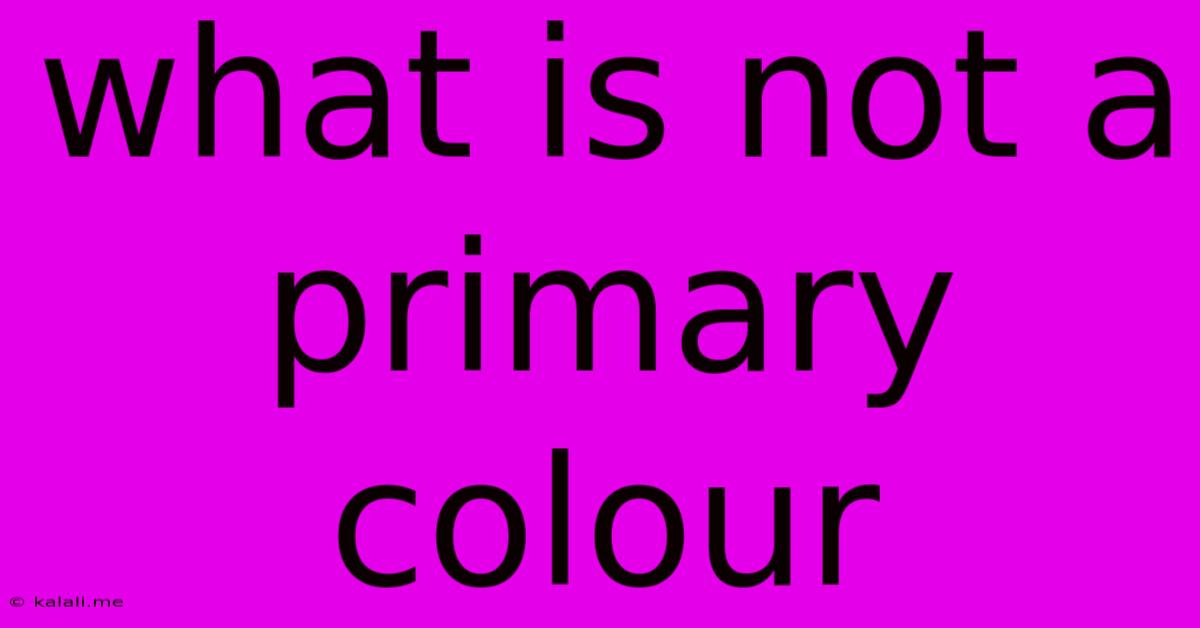What Is Not A Primary Colour
Kalali
Jun 14, 2025 · 2 min read

Table of Contents
What Is Not a Primary Color? Understanding Color Theory Basics
This article delves into the fascinating world of color theory, specifically addressing the question: what is not a primary color? Understanding primary colors is crucial for artists, designers, and anyone interested in visual communication. We'll explore the definition of primary colors, examine colors that fall outside this category, and briefly touch on secondary and tertiary colors.
What are Primary Colors?
Before we can define what isn't a primary color, we need to understand what is. Primary colors are a set of colors that cannot be created by mixing other colors together. They form the basis for all other colors. In the most common color model, the additive RGB model (used in screens and digital displays), the primary colors are Red, Green, and Blue (RGB). In the subtractive CMYK model (used in printing), the primary colors are Cyan, Magenta, and Yellow (CMY), along with black (K). This article focuses on the RGB model for simplicity.
Colors That Are NOT Primary Colors:
Any color that can be created by mixing red, green, and blue is not a primary color. This includes a vast range of colors, such as:
- Secondary Colors: These are colors created by mixing two primary colors in equal proportions. For example, mixing red and green creates yellow, red and blue creates magenta, and blue and green creates cyan. These are not primary because they are derived from the primary colors.
- Tertiary Colors: These are colors created by mixing a primary color with a nearby secondary color. For example, red-orange (red + orange), blue-green (blue + green), etc. Again, these are not primary as they are combinations of other colors.
- All other colors: This encompasses the huge spectrum of colors visible to the human eye—browns, oranges, purples, pinks—all are derived from various combinations of red, green, and blue (in the RGB model). They are not considered primary because they require mixing.
Understanding Color Mixing:
The process of color mixing is different depending on whether you're working with light (additive) or pigment (subtractive).
- Additive Color Mixing: This is how colors are mixed on screens. Adding red, green, and blue light together creates white light.
- Subtractive Color Mixing: This is how colors are mixed with paints or inks. Mixing cyan, magenta, and yellow pigments together creates black (or a very dark brown, often needing additional black ink for true black).
In Conclusion:
To summarize, any color that is not red, green, or blue (in the RGB additive model) is not a primary color. Understanding this basic principle of color theory is vital for anyone working with color in any creative field. This includes digital art, graphic design, web design, and even photography, where color adjustments often involve manipulating the RGB values of an image. Mastering this foundational concept opens doors to a deeper understanding of color manipulation and creative expression.
Latest Posts
Latest Posts
-
The Vulva Includes All Of The Following Except The
Jun 15, 2025
-
Lcm Of 3 6 And 7
Jun 15, 2025
-
Area Of Nepal In Sq Km
Jun 15, 2025
-
Who Is Considered The Father Of Modern Psychology
Jun 15, 2025
-
Excel Is An Example Of What Type Of Software
Jun 15, 2025
Related Post
Thank you for visiting our website which covers about What Is Not A Primary Colour . We hope the information provided has been useful to you. Feel free to contact us if you have any questions or need further assistance. See you next time and don't miss to bookmark.